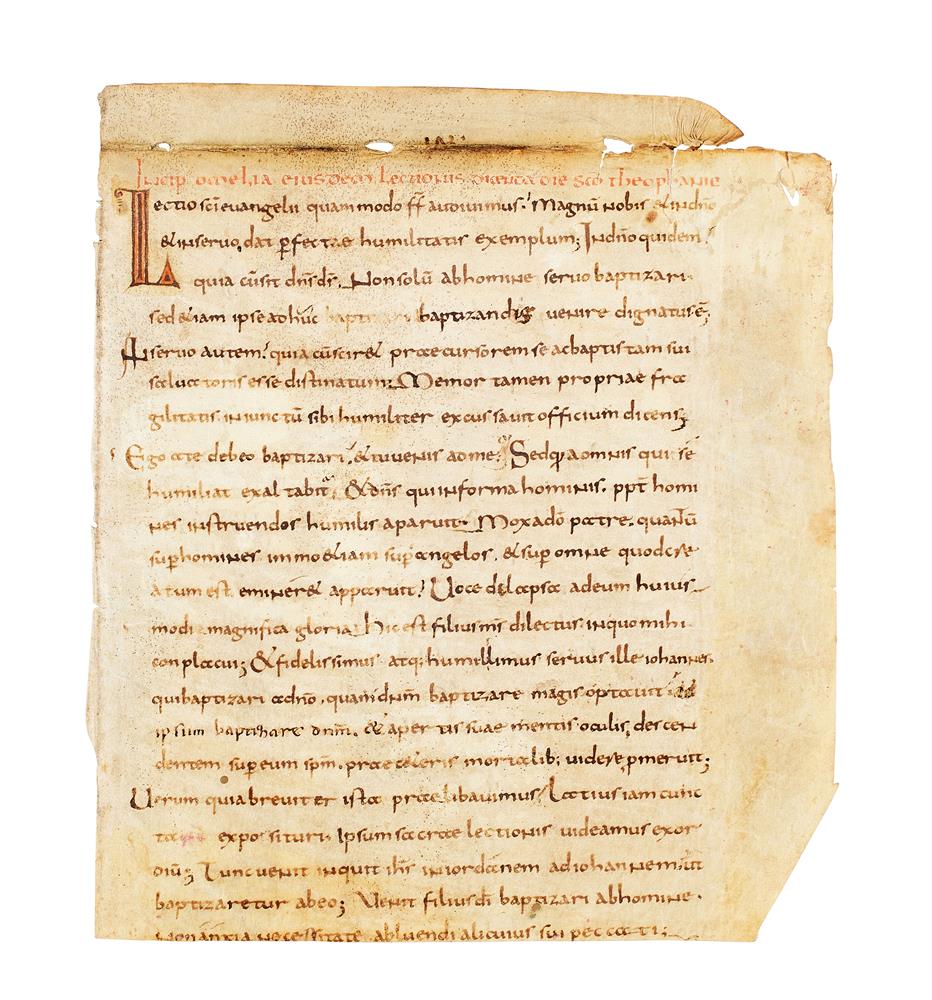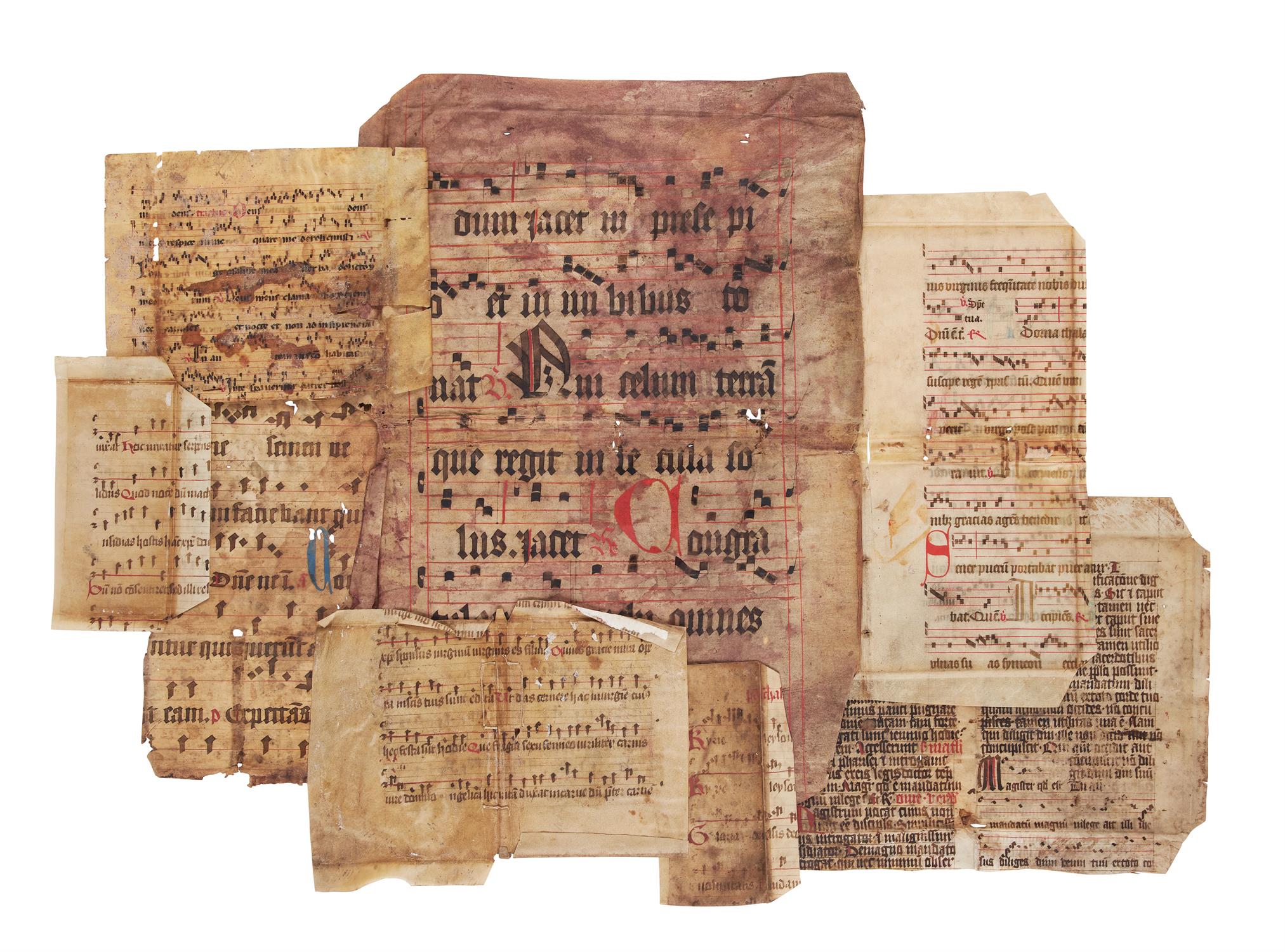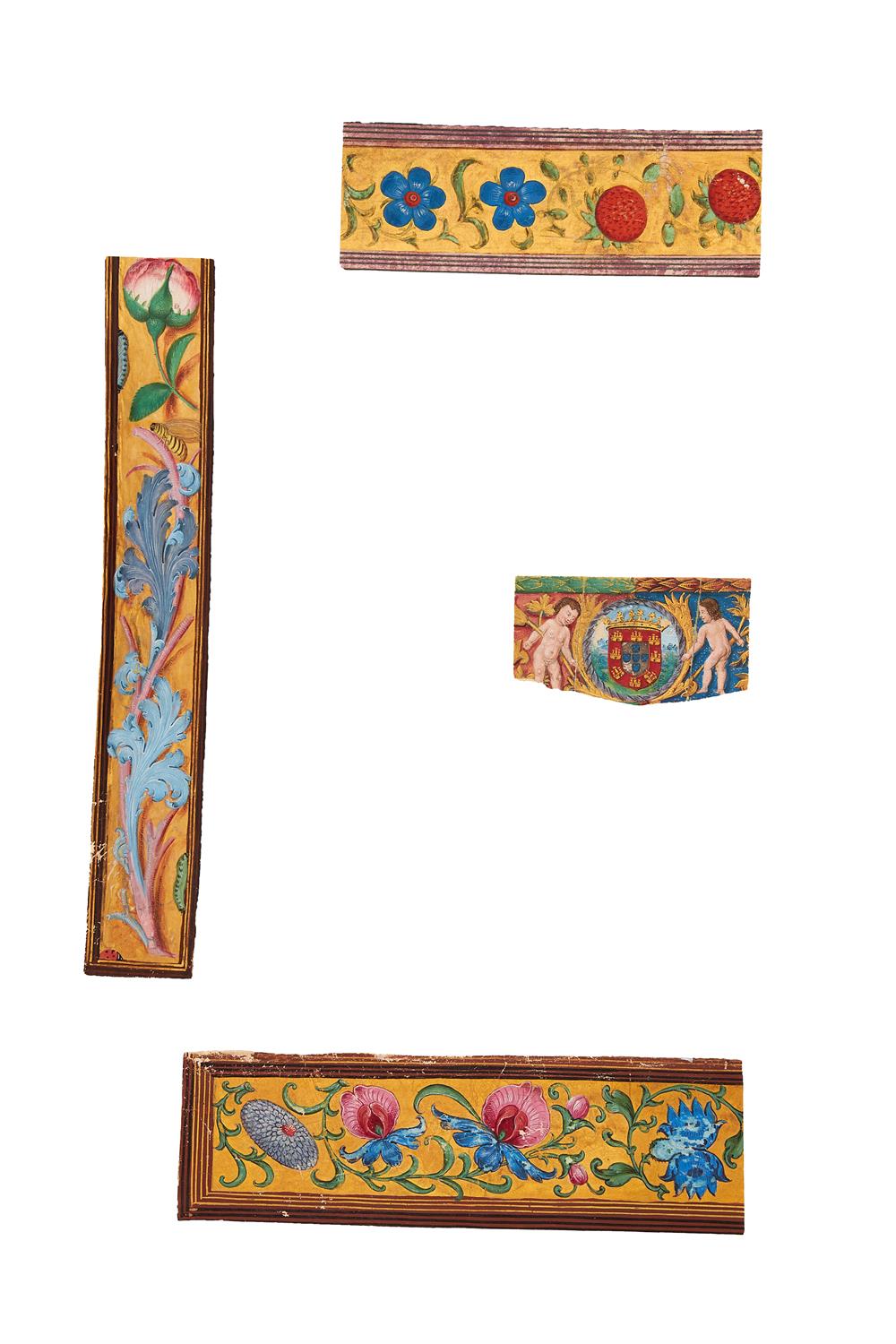Three cuttings from a large and elegant Carolingian copy of Gregory the Great, Homiliary, in Latin, decorated manuscript on parchment [France (most probably Loire valley, perhaps Angers), ninth century] Two cuttings making up a single leaf (bisected laterally; with Homily X) and a large cutting from the centre of another leaf (trimmed away margins, upper part of text and a few cms of the outermost column; with Homily I), from a large manuscript with text originally in double column of 35 lines of an excellent and refined Carolingian minuscule with a frequent 'nt'-ligature, occasional use of the et-ligature integrally within words, distinctive half 's' shapes in the tails of the letters 'g' and 'z', capitals touched in pale red wash, rubrics and simple initials in pale red, the third cutting with a very large initial 'd' in uncial form enclosing 'NS' (together an abbreviation for 'Dominus', the opening of 'Dominus [ac Redemptor noster, paratos nos inuenire desiderans] senescentem ...'; the preceding text part of the prologue), reused together to form bindings for seventeenth-century account books and with inscriptions of that date (see below), loss of a single line at cut-point from bisected leaf, some folds and small areas of discolouration, else in good condition and on fine and heavy parchment, each cutting approximately 265 by 170mm. (the complete bisected leaf once 344 by 263mm.) Provenance: 1. Given their reuse for accounts in the immediate vicinity of Angers, the parent volume was perhaps written for, and by, the abbey of Saint Aubin d'Angers (founded in the sixth or seventh century, next to the funerary chapel of St. Albinus (d. 550), who is remembered as working to free prisoners and campaigning against incestuous marriages in the Merovingian nobility). Little is known in detail of the house, but in the eighth or ninth century the monks were displaced for a community of canons, and in 818-20 Bishop Théodulf of Orléans was detained there. The monks returned in 966 and the community flourished until their forced closure during the Secularisation. If this is correct, then these are important fragments; Bischoff notes that there are no Carolingian manuscripts from Angers beyond the possible example of a late eighth-century legal codex (now Fulda, D.I; Manuscripts and Libraries in the Age of Charlemagne, 1994, p. 30). 2. Reused in the seventeenth century on account books for properties to the immediate south west of Angers: with inscriptions recording that these leaves were reused to cover accounts for 1668, 1678 and 1681, for 'La Iubaudere' (La Jubaudière in Maine-et-Loire) and 1679 for 'La Seguinere' (a nearby village in Maine-et-Loire, west of Cholet). The re-use of the leaves here on accounts predates the closure of the community by approximately a century, and so these were probably re-used by the monastic community themselves on their own records. 3. Acquired in 2010 in a Swiss auction. Script and decoration: The hand here is a clean and practised Carolingian minuscule, of the form championed by the scriptoria of nearby Tours during the Carolingian script revolution of the late eighth and early ninth century. However, the simple and almost austere red initials here, especially that of the large uncial 'd', stands apart from the riotously coloured and geometric initials of Tours (for examples see F. Mütterich, 'Dir touronische Bibel von St. Maximin in Trier' and 'Die Initialen der tourischen Bibel von St. Maximin', in Studies in Carolingian Manuscript Illumination, 2004, pp. 341-60 and 361-74) bringing great elegance to the page here with the minimum of effort.
Three cuttings from a large and elegant Carolingian copy of Gregory the Great, Homiliary, in Latin, decorated manuscript on parchment [France (most probably Loire valley, perhaps Angers), ninth century] Two cuttings making up a single leaf (bisected laterally; with Homily X) and a large cutting from the centre of another leaf (trimmed away margins, upper part of text and a few cms of the outermost column; with Homily I), from a large manuscript with text originally in double column of 35 lines of an excellent and refined Carolingian minuscule with a frequent 'nt'-ligature, occasional use of the et-ligature integrally within words, distinctive half 's' shapes in the tails of the letters 'g' and 'z', capitals touched in pale red wash, rubrics and simple initials in pale red, the third cutting with a very large initial 'd' in uncial form enclosing 'NS' (together an abbreviation for 'Dominus', the opening of 'Dominus [ac Redemptor noster, paratos nos inuenire desiderans] senescentem ...'; the preceding text part of the prologue), reused together to form bindings for seventeenth-century account books and with inscriptions of that date (see below), loss of a single line at cut-point from bisected leaf, some folds and small areas of discolouration, else in good condition and on fine and heavy parchment, each cutting approximately 265 by 170mm. (the complete bisected leaf once 344 by 263mm.) Provenance: 1. Given their reuse for accounts in the immediate vicinity of Angers, the parent volume was perhaps written for, and by, the abbey of Saint Aubin d'Angers (founded in the sixth or seventh century, next to the funerary chapel of St. Albinus (d. 550), who is remembered as working to free prisoners and campaigning against incestuous marriages in the Merovingian nobility). Little is known in detail of the house, but in the eighth or ninth century the monks were displaced for a community of canons, and in 818-20 Bishop Théodulf of Orléans was detained there. The monks returned in 966 and the community flourished until their forced closure during the Secularisation. If this is correct, then these are important fragments; Bischoff notes that there are no Carolingian manuscripts from Angers beyond the possible example of a late eighth-century legal codex (now Fulda, D.I; Manuscripts and Libraries in the Age of Charlemagne, 1994, p. 30). 2. Reused in the seventeenth century on account books for properties to the immediate south west of Angers: with inscriptions recording that these leaves were reused to cover accounts for 1668, 1678 and 1681, for 'La Iubaudere' (La Jubaudière in Maine-et-Loire) and 1679 for 'La Seguinere' (a nearby village in Maine-et-Loire, west of Cholet). The re-use of the leaves here on accounts predates the closure of the community by approximately a century, and so these were probably re-used by the monastic community themselves on their own records. 3. Acquired in 2010 in a Swiss auction. Script and decoration: The hand here is a clean and practised Carolingian minuscule, of the form championed by the scriptoria of nearby Tours during the Carolingian script revolution of the late eighth and early ninth century. However, the simple and almost austere red initials here, especially that of the large uncial 'd', stands apart from the riotously coloured and geometric initials of Tours (for examples see F. Mütterich, 'Dir touronische Bibel von St. Maximin in Trier' and 'Die Initialen der tourischen Bibel von St. Maximin', in Studies in Carolingian Manuscript Illumination, 2004, pp. 341-60 and 361-74) bringing great elegance to the page here with the minimum of effort.







Testen Sie LotSearch und seine Premium-Features 7 Tage - ohne Kosten!
Lassen Sie sich automatisch über neue Objekte in kommenden Auktionen benachrichtigen.
Suchauftrag anlegen